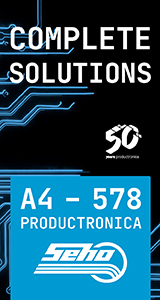|

|
|
| Ask the Experts | |||||||
|
|||||||
|
September 1, 2017 - Updated September 30, 2007 - Originally Posted Clean before wave solderingIs it necessary to clean (using isopropyl alcohol) PCBs before wave soldering? If it is necessary, then why? If not, then why? Is there alternative practice for this process? V. S. |
|||||||
| Expert Panel Responses | |||||||
|
The first objective especially if the PCB assembly is being manufactured using No clean technology is to avoid handling and contamination where ever possible. Handling contamination will have the potential for two effects
Marketing 360-Biz Douglass Dixon is the Chief Marketing Officer for 360 BC Group, a marketing agency with offices throughout the US. 360 BC specializes in consulting and implementing successful marketing programs that utilize the latest in marketing, sales and technology strategies. As an electronics veteran, Dixon has worked in the industry for over 30 years for companies like Henkel, Universal Instruments, Camelot Systems, and Raytheon. Dixon's electronics industry experience includes a broad skill set that includes engineering, field service, applications, product management and marketing communications expertise.
In my 20 years of experience in PCB assembly, the only time I have seen companies clean before soldering was in very high-end aerospace and military requirements. And there is some logic to this…. The most corrosive or damaging residues on a PCB are the salts (also called "halites" or "activators") that are in the fluxes. They make the flux "wetter" and help the soldering materials flow into each other, creating stronger solder joints. But heat increases the rate of corrosion development, and a warm circuit board in a working electronic device can develop dendrites and other corrosive conditions in just weeks or months. So cleaning AFTER soldering should, in theory, remove these residues and provide PCBs with longer operational lives. But over the years a few companies cleaned before soldering. Their logic was that cleaning was a cheap way to ensure that (a) no contamination was trapped in the solder joints, which would create a weak joint, and (b) no contamination blocked the flow of solder and produced incomplete wetting. After all, there are many other contaminates on circuit boards besides just fluxes: fingerprints contain salts and oils; but also dust, marking inks, Kapton tape residues, and even humidity all are found on the boards and can cause problems. By removing all those residues they increase the chances for perfect soldering and decrease the opportunities for problems. There's no doubt that pre-cleaning adds expense to the manufacturing process. So unless you're building a space probe that's engineered for cruising through the solar system, in most cases it is an expense that's hard to justify. My suggestion would be to do a systematic test of 200 boards; clean 100 and don't clean the others, and see if your QC people can detect any differences.
Vice President Micro Care Mr. Jones is an electronics cleaning and stencil printing specialist. Averaging over one hundred days a year on the road, Mike visits SMT production sites and circuit board repair facilities in every corner of the globe, helping engineers and technicians work through the complex trade-offs today's demanding electronics require.
This would only be required if there were heavy deposits of grease or other contaminates on the PCB. Otherwise the normal cleaning action of the flux will provide the cleaning necessary for the soldering operation.
Regional Sales Manager OK International Inc. Ed Zamborsky is a Regional Sales & Technical Support Manager for Thermaltronics, located in New York. His position requires frequent customer visits throughout North America and the Caribbean and his position encompasses not only sales but the role of trainer and master applications engineer for all of Thermaltronics products. His expertise includes such specialties as hand soldering, convection and conduction reflow techniques, array rework, fluid dispensing equipment, and fume extraction. Ed has authored many articles and has presented many papers on topics such as; Low Volume SMT Assembly, Solder Fume Extraction, SMT Rework, BGA Rework, Lead-Free Hand Soldering, High Thermal Demand Hand Soldering, Lead Free Visual Inspection and Lead Free Array Rework.
Cleaning PCB's before wave soldering is certainly not a normal procedure. The only reason I can think of that would require cleaning is if the boards had been contaminated with some material that required IPA to remove. Boards should not be handled with bare hands as the oils in the skin can contaminate the solder pads and interfere with the solder process.
Senior Applications Engineer Speedline Technologies Greg joined Electrovert in February 1984. Based out of the Electrovert applications laboratory in Camdenton Missouri, Greg has been in the process applications support role since 2000. His primary responsibilities include providing process and machine applications support for the wave soldering lines as well as process, machine and operations training. He also provides applications support for the reflow and cleaner lines. Greg is a PBET certified trainer and holds two patents on wave solder nozzle design.
|
|||||||
| Submit A Comment | |||||||
|
Comments are reviewed prior to posting. You must include your full name to have your comments posted. We will not post your email address. |
|
Free Newsletter Subscription
Circuitnet is built for professionals who bear the responsibility of looking ahead, imagining the future, and preparing for it. Insert Your Email Address |
|

|






